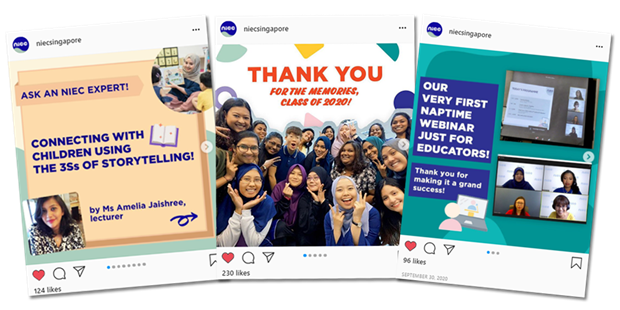Resources



Hey Educators,
Huge appreciation to all who’ve joined us for our “Can I borrow your R.U.L.E.R?” Naptime Webinar with Dr. Yvonne Chan (NIEC-City)!




Through the webinar, many of you learnt how to better help children recognise, express and regulate their emotions, and found out new strategies to develop their social and emotional well-being. Most important takeaway though, was the reminder that it’s alright to feel the way you do – adults and children alike.
If you didn't manage to catch the webinar
Watch the key highlights below!
Here, Dr. Yvonne teaches us how we can better Recognise, Understand, Label, Express and Regulate emotions!
Mrs. Loke (Director, NIEC) and Ms. Sharon Toong (Lecturer, NIEC-NP) joined Dr. Yvonne in sharing useful strategies for educators to help children deal with big feelings.
Can't get enough of the R.U.L.E.R strategy?
Listen to NIEC’s Podcast here!
Answers to your questions
Many of you were eager to learn how to better develop Social & Emotional Learning (SEL) in children. So, we’ve decided to post the strategies shared during the webinar here!
For younger children
Younger children often do not have the vocabulary to express how they feel verbally, so some of them will express their feelings by using their own language, their bodies or actions that may not be appropriate. These are ways educators can identify that a child is trying to overcome big feelings. At this point, educators can stay by the child’s side, ensure that the environment is safe and allow the child to calm down. Once they feel better, have a conversation on their feelings with them.
For older children
Older children tend to have the ability to express themselves through language and so, educators can use thought-provoking questions to help them process what is happening. Educators can use the R.U.L.E.R approach to get children to think about what is happening, what is causing them to feel this way and even empower them to come up with strategies to feel better.
Educators can also use books to equip children with strategies to help them cope with strong emotions like sadness, anxiety and stress. Books can be used to illicit responses from the children on what they can do when experiencing these feelings and form a collage of useful strategies based on the responses. For a list of books you can use to help children learn and deal with emotions, click here!
It is important to know the age group of the child and the developmental trajectory. If the child is in a younger age group, they may not be able to articulate or express themselves. Hence, you will need to build a trusting and safe relationship with the child first before she/he will open up or be more willing to listen. For example, if a toddler is crying, the educator can go up to her/him and say “Oh, I see that you are crying. I think you have soiled yourself and must be feeling very upset. Don’t worry, let’s go and take a bath and once you are dried up and dressed, we can go take a little nap.”
Apart from this strategy, there is a hierarchy of prompts that educators can consider using to help children recognise, express and regulate their emotions. When the first prompt does not work, use the next!:
- Verbal: Always remember to allow the child to use his/her way of expressing (e.g.: nodding as a way of saying ‘yes’)
- Gesture: Educators can also model the emotion by showing it on their faces. This will help children to relate to the emotions
- Visual cues: Educators can use pictures or videos to help the child express their emotions or to self-regulate
By recognising children’s emotions, you are showing them you are making a conscious effort to understand and care for them.
You can help the child to understand using a 3-step strategy:
Step 1: Help the child understand what others are doing and what she/he is supposed to do in that situation
Step 2: Help them to regulate their feelings by using strategies (e.g.: R.U.L.E.R strategy)
Step 3: Problem-solve with them! Direct them to express their feelings in a more appropriate manner in that situation.
When a child is having big feelings and are expressing themselves, she/he will not be in the right frame of mind to listen to what you have to say. By giving them space and time, not only are you allowing the child to experience the emotions but you are also affirming the child that it’s ok to feel them. Once the child cools down, you can then use the strategies you learnt to help them recognise and regulate their emotions. You might even be pleasantly surprised – the child might just find his/her own ways to calm him/herself down!
First, find out their interests so that you can get them to participate in things they like to do. This distracts and helps regulate their emotions. You can even use puppets to divert their attention or calm them down before talking to them.
Make sure to stay calm and keep everyone safe. Assign a calm space/corner for the child and allow them time to cool down before talking to them about their emotions. Use the R.U.L.E.R strategy as a guide and go through the steps until they are feeling better. You can also incorporate breathing strategies or turn their attention to another activity. Most importantly, don’t forget to praise them when they are doing the right thing! For the younger age group, distracting them with items/activities of interest will help to regulate their emotions.
Children with developmental needs do not learn social-emotional skills the same way as typically developing children and hence, educators should tweak the way in which these skills are taught.
It is important for educators to know the current developmental age, and not the chronological milestone, of the child. For instance, if a 5-year-old child has a SEL milestone of a 2-year-old, the educator will need to work with the child on the social-emotional needs for a 2-year-old.
In most cases, the social skills remain the same in that milestone but educators can implement explicit teaching. For example, explicit teaching can come in the form of educators providing steps to help a child make friends:
- Step 1: Smile
- Step 2: Say Hi
- Step 3: If your friend doesn’t want to play, let’s find another friend, smile and say hi. If your friend smiles and says hi back, how about inviting your friend to play?
Role play (like the above), stimulation exercises and customised social stories can help children to learn social skills and acceptable behaviours.
It is important that educators cultivate good relationships with parents and continue to have conversations on their child(ren)’s social-emotional development. Make known your intention and the importance of SEL to the parents, and find opportunities to share their child(ren)’s social-emotional milestones or success stories in the classroom (e.g.: John made 2 new friends today).
Centres may even want to organise outreach activities, such as workshops, where parents are invited to know more about what is done in the centre to support children in their social-emotional development. During the Naptime Webinar, Sharon (Lecturer, NIEC-NP) also recommended that centres can have a “Social Emotional Awareness Learning Day” where parents come and be a child for the day! Educators can then demonstrate the social-emotional skills they use in the classroom, which will help in convincing parents on the importance of SEL.

For more resources

Click here to download the digital handout for model questions you can use to promote social and emotional growth in children, as well as a visual cue board to help children express their emotions!

Click here for useful learning resources which you can use to enhance your knowledge on social-emotional development strategies to better support children.
Stay connected with the NIEC fraternity
Click on the ‘Join Mailing List’ button on the right and be the first to know about our upcoming workshops, webinars and more!
Join us on social media too!

Stay up-to-date with expert tips from our faculty, event highlights, and other fun content for EC educators.
Follow us @NIECSingapore!

